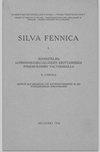The effect of stem girdling on xylem and phloem formation in Scots pine
IF 1.7
3区 农林科学
Q2 FORESTRY
引用次数: 16
Abstract
Scots pine (Pinus sylvestris L.) is a resilient, wide spread species. This paper reports on the xylem and phloem cell formation process, before and after, the species was put under artificial stress by stem girdling. Microcore method was applied to a healthy control group and a standing group of girdled trees within an 80-year-old pine forest for two consecutive growing seasons (2013 and 2014). The stem girdling was applied in the middle of the first growing season (July 2013). Cambial activity timings (onset and cessation of cell division), cell formation intensity, cell differentiation, and the dynamics of the annual radial increment in the stem were analyzed. Cambial activity was inhibited and eventually ceased below the stem girdling immediately after the removal of the strip. Therefore, no latewood tracheids were formed. However, above the stem girdling and in the control trees, cell formation and tissue differentiation continued until the end of the growing season, with the girdled trees moving at a less intensive pace but for a longer period of time. During the following growing season (2014), the cambial zone was reactivated only above the stem girdling, not below, and eventually the girdled trees died. In 2014, the onset of the cambial activity was delayed and the division rate of the cells was slower in the girdled trees. Furthermore, the girdled trees formed less phloem cells than the control trees.树干环剥对苏格兰松木质部和韧皮部形成的影响
苏格兰松(Pinus sylvestris L.)是一种适应性强、分布广泛的物种。本文报道了木质部和韧皮部细胞的形成过程,在此之前和之后,该物种通过茎环剥受到人工胁迫。将Microcore方法应用于一个连续两个生长季节(2013年和2014年)的80年松林内的健康对照组和一组直立环带树。在第一个生长季节中期(2013年7月),进行了茎环束。分析了茎的活动时间(细胞分裂的开始和停止)、细胞形成强度、细胞分化和茎中每年径向增量的动力学。在去除条带后,剑桥活性被抑制,并最终在茎环剥下方立即停止。因此,没有形成晚材管胞。然而,在树干环带上方和对照树中,细胞形成和组织分化一直持续到生长季节结束,环带树的移动速度较低,但持续时间较长。在接下来的生长季节(2014年),形成层仅在树干环带上方而非下方重新激活,最终环带树木死亡。2014年,围带树形成层活动的开始被推迟,细胞的分裂速度较慢。此外,环带树形成的韧皮部细胞比对照树少。
本文章由计算机程序翻译,如有差异,请以英文原文为准。
求助全文
约1分钟内获得全文
求助全文
来源期刊

Silva Fennica
农林科学-林学
CiteScore
3.50
自引率
11.10%
发文量
21
审稿时长
3 months
期刊介绍:
Silva Fennica publishes significant new knowledge on forest sciences. The scope covers research on forestry and forest ecosystems. Silva Fennica aims to increase understanding on forest ecosystems, and sustainable use and conservation of forest resources. Use of forest resources includes all aspects of forestry containing biomass-based and non-timber products, economic and social factors etc.
 求助内容:
求助内容: 应助结果提醒方式:
应助结果提醒方式:


